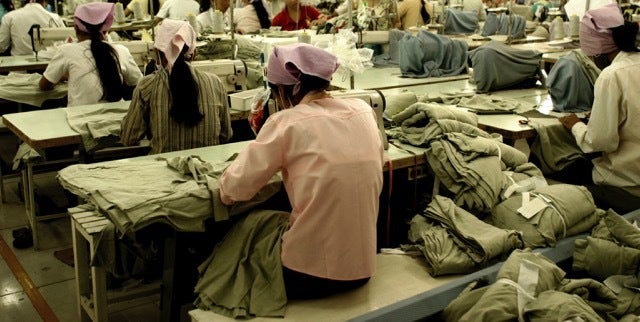
As consumers, our garments intricately connect us to the men and women who made them. But does this connection make us wonder about the lives of the people across the globe who make our clothes?
The answer today is probably no, in large part because many people don’t know where and how their clothes are made. Seeing first hand the working conditions at apparel factories changes the way you approach shopping. It did for me. Considering the lives of the workers who made a piece of clothing you bought may make you think twice about the purchase, like those $10 jeans or $5 T-shirt. You begin to realize that the clothes that you wear are more than their brand, more than the price you paid for them, more than something to keep you clothed and warm. Within a pair of jeans is a story of the lives of each worker that contributed to making them—their hardships, their smiles, their hard work, their hopes.
An example: On average, 45 pairs of hands touch a pair of Levi’s jeans before they even leave an apparel factory. These hands are those of the workers who dyed the material the jeans are made of, cut them into the right shape and size, sewed them, washed them, dried them, folded them, checked them for imperfections, and tagged them.
Knowing this, maybe you begin to wonder about their lives. How different they may be from yours? What are their working conditions? Are they able to support their families? Are they proud of their job? Are women treated equally to men?
These are the questions Levi Strauss & Co. (LS&Co.) asks itself every day. And the company is working harder than ever to get answers with the help of the Sustainability and Health Initiative for NetPositive Enterprise (SHINE), where I work as a Project Manager. SHINE is a young program at the Center for Health and the Global Environment at the Harvard T.H. Chan School of Public Health, that was created to bridge the gap between human health and corporate sustainability.
LS&Co. was the first company in 1991 to create a code of conduct for its suppliers that established a set of labor and environmental standards. Today, LS&Co. is leading the effort to build on this legacy by going beyond compliance to actually improve and add value to the lives of the workers who make its products. Introduced in 2011, the Worker Well-being initiative aims to address the health and well-being needs of the workers in a systemic and sustainable way. In partnership with the company’s suppliers, workers are surveyed to identify their needs, then programs are implemented with local partners.
To further the initiative and gather additional evidence for the business case of supporting well-being, LS&Co. sought out SHINE to develop a universal tool to benchmark worker well-being in the supply chain. This survey toolkit is meant to provide suppliers with a dashboard to track key performance indicators around workers’ overall levels of engagement, health and well-being beyond typical business measures. This will allow suppliers to better understand and analyze the impact of well-being on their workers and business in real-time.
The project was piloted in July in Sri Lanka at three apparel factories where LS&Co. garments are produced.
“This model offers unique information because confidential data is self-entered by workers and goes behind the Harvard firewall. Our goal is to create an open source data pool with anonymity that builds a common language for worker well-being and reporting in the supply chain,” says Eileen McNeely, Co-Director of SHINE.
The database will offer proof points for the business case to invest in worker well-being, as well as, insight to how population health can be influenced at the workplace.
“Working in tandem with on-the-ground partners ensures trust, support and ownership of the goals and ensures that these programs are fully embedded into the way the factories operate and do business,” says Kim Almeida, Senior Program Manager at the Levi Strauss Foundation, who is leading the company’s well-being efforts in the supply chain.
A new wave of supply chain sustainability that is inclusive of a more integrated approach to worker well-being, beyond current health and safety standards, is on the horizon. The results of the data collection on this project will be key for this momentum. Given that enlightened factory leaders understand the business case, there is hope for a major positive transformation in supply chain health and sustainability.
